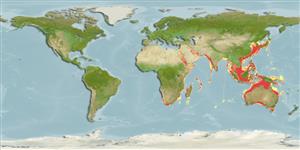Common names from other countries
Environment: milieu / climate zone / depth range / distribution range
Sinh thái học
Ở đại duơng, biển (Ref. 75906); Mức độ sâu 0 - 2000 m, usually 1 - 50 m. Tropical; 90°N - 90°S, 15°E - 180°E
Indian Ocean and Western Pacific Ocean.
Length at first maturity / Bộ gần gũi / Khối lượng (Trọng lượng) / Age
Maturity: Lm ?, range 208 - 220 cm Max length : 270 cm BL con đực/không giới tính; (Ref. 104989); Khối lượng cực đại được công bố: 230.0 kg (Ref. 104988)
They prefer living on seagrass meadows and rocky substrata (Ref. 114971). Feeds on bony fishes and cephalopods (Ref. 84677). Attacked and preyed upon by tiger sharks Galeocerdo cuvier (Ref. 104930). This species was reported to display complex prey handling of the benthic-dwelling Maori octopus (Macroctopus maorum), processing its prey by shaking and tossing (Ref. 122728). The same octopus was reported to have asphyxiated an adult male of this species, with the octopus arms protruding from the mouth and the rest of the body blocking the pharynx, larynx and
esophagus (Ref. 122729). Occurs in pods of various numbers (Ref. 129713).
Rice, D.W. 1998. (Ref. 1522)
IUCN Red List Status (Ref. 130435)
CITES status (Ref. 108899)
Human uses
Các nghề cá: Tính thương mại; mồi: usually
FAO - Các nghề cá: landings | FishSource | Biển chung quanh ta
Các công cụ
Thêm thông tin
Age/SizeSự sinh trưởngLength-weightLength-lengthHình thái họcẤu trùngSự phong phú
Các nguồn internet
Estimates based on models
Preferred temperature
(Ref.
115969): 21.9 - 29, mean 27.6 (based on 2288 cells).
Price category
Unknown.
